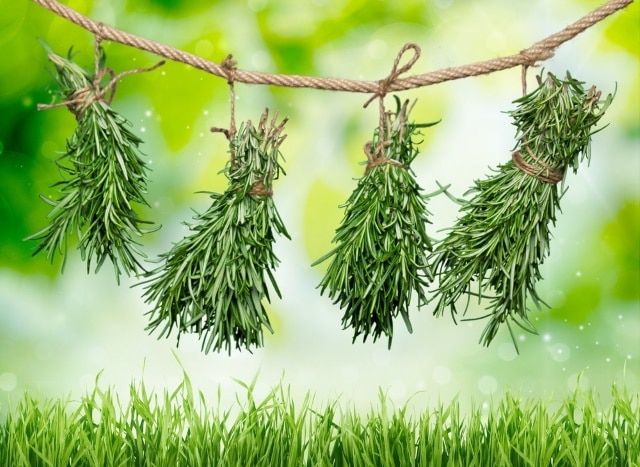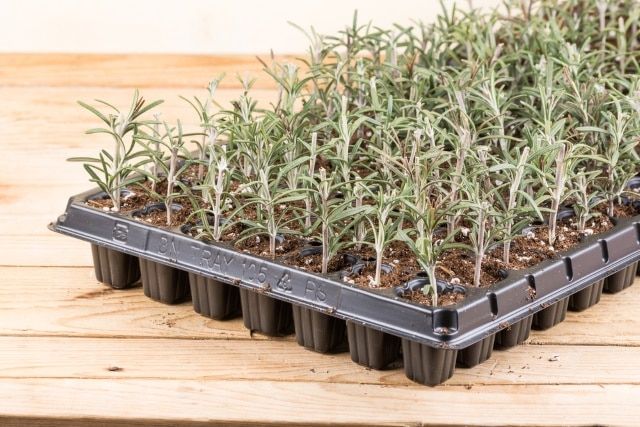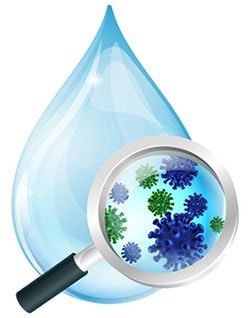You’ve likely heard of rosemary and might have even used it when you cook. It’s a pretty popular herb, but you may not realize that it’s a great one to have on hand, especially when it’s fresh.
Growing rosemary from cuttings or from seed requires a little work, but it’s not a difficult process, and once you’ve started the growth, you never have to start fresh planting seeds, since rosemary grows well from cuttings. What is it about this particular herb that attracts so many people to it? How do you grow and care for it, and what is it used for? What’s the best fertilizer for rosemary? What’s the best soil for rosemary? The questions are endless, so let’s take a look at this herbaceous plant first and find out more about it with these growing tips, planting guide, and care instructions.
What is Rosemary?
Rosemary is a perennial woody herb that is native to the Mediterranean region of the world but has become popular across the globe and is, in fact, one of the main herbs you can expect to find when you buy a spice rack. In addition, because it is not just tasty but also extremely aromatic, it’s used in many potpourris and incense that you can buy.
The word ‘rosemary’ comes from Old Latin. The phrase “Ros Marinus” means “dew of the sea” and was likely derived from the fact that rosemary grew in the regions close to the Mediterranean Sea. The scientific name is Rosmarinus officinalis, and it’s related to mint, though you’d never know it by the flavor. Rather, it’s very notable flavor is warmer, more bitter, and more astringent than its cousin, as well as a number of other herbs. It’s used to cook a number of dishes in very small quantities since large amounts can overwhelm the overall desired flavor.
At the same time, rosemary has a number of other valuable properties that make them a great addition to your diet. Still, you may want to consider that, since it comes in such small quantities, you could easily add rosemary to almost any dish and reap the many benefits it offers if you grew it yourself. Growing rosemary is no more difficult than any other herb, so you can easily add it to any herb garden and start enjoying the health benefits and the unlimited aroma and flavor you can get from this herb.
One other benefit that comes from rosemary is that it grows beautifully outside. It easily reaches a height of 3 feet with needle-like blades and can continue to grow up to 5 feet if not trimmed back, especially in very warm climates and popular growing zones. Actually, in very warm regions, rosemary works as an evergreen addition to your yard. In colder regions, it’s simple to plant your rosemary in pots that can be brought inside during the winter or to keep them in an indoor herb garden.
How to Grow & Cultivate Rosemary
When you initially plant rosemary, you have to be patient. During the first year, it will grow very slowly. However, in the second year, growth will pick up exponentially, and you’ll reap the rewards for your patience.
You may have asked yourself where to grow rosemary. Whether you plant your rosemary indoors, outdoors, or in a pot or planter that can be moved during cold weather, you’ll start the process the same way. What’s the best soil for rosemary? You should have uniformly moist soil that is well drained so it doesn’t cause rot in the roots as your plants start to grow or make the seed too mushy to grow properly.
Make sure to add some potting soil with feed for vegetables and herb to your top layer of soil. This will improve the speed at which the rosemary starts to take root wherever you’ve planted it. You don’t need a lot, just enough to infuse the soil with additional food for the plant to grow healthy.
If you’re planting seedlings, you should space them 2 to 3 feet apart in your yard, preferably in early or mid-spring. Some people have asked us ‘does rosemary needs full sunlight’ as well as ‘when is the best time to plant rosemary’? You’ll want to assure that the location you choose gets lots of direct sunlight throughout the day. You could plant rosemary in a location with partial shade since the plant will tolerate these conditions. However, this particular herb prefers full sun and lots of light and will thrive better in such an environment.
If you’re planting from cuttings of mother plants, use some root growth hormones on the cut ends to promote the quicker growth of roots, which will help your cuttings grow stronger faster. Once they’ve taken secure root in a planter, you can treat them similarly to the seedlings described above, planting them 2 to 3 feet apart in your yard.
Once you’ve planted, it’s important to maintain a consistent moisture across the entire location where you’ve planted your rosemary. Allow the soil to dry out between watering times, and be sure to use mulch. This will keep the soil moist during the summer and insulated during the winter against the cold and freezing temperatures.
How to Harvest Rosemary
When it’s time to harvest rosemary, you’ll find it much easier than some plants you may have tried in the past. First, you can harvest stems at any time, simply cutting them with a sharp knife or shears that leave both the mother plant and the cutting undamaged.
Don’t use the rosemary immediately. This herb, like so many, should be dried first. You can dry rosemary on a rack or hanging upside down to get the best results. Once the stem you cut has dried completely, you can strip the leaves for use in cooking or in making an aromatic potpourri.
In addition, you may want to keep the stems. These can add flavor to oil and butter or be preserved in vinegar. You can also freeze rosemary sprigs to save for later use in cooking. It just depends on what part and how much you harvest as to what you may want to do with it. Having fresh rosemary available at any time can really kick up your ability to get creative in the kitchen or with incense and other things that can make your indoor living areas smell more appealing.
Pests and Diseases Common in Rosemary
Like all plants, rosemary can fall prey to various diseases and pests that can be detrimental to their health and growth. Preventing and treating these problems goes a long way in assuring you have the beautiful and tasty herbs you want.
Rosemary is a fairly healthy plant, and it can withstand some insects and other pests. However, you want to treat those that harm other plants in your garden, keeping not only your rosemary safe but also the other growing things in your yard and garden. The most common pests you’ll find in your garden that could be detrimental to rosemary are whiteflies, aphids, earwigs, and cutworms. If you’re worried about using chemical insecticides, there are organic alternatives you can use to avoid these pesky critters.
More importantly for rosemary, you need to be concerned about diseases that could cause problems for the plant. Aerial blight, also known as Rhizoctonia foliar blight, infects stems, pods, and leaves of the plant. It can significantly reduce the yield of plants like rosemary and eventually cause death in the plant. While the fungus isn’t typically a concern, bacteria leaf spots could also affect your rosemary, as it does a number of edible plants. These are manifested as dark, necrotic spots on the leaves. In addition, rosemary easily succumbs to various types of root rot, which is why it’s important to have the soil drain properly and to let it dry out between watering times. Mulching the soil can aid in reducing the risk of this. growing rosemary in an indoor herb garden can significantly reduce the likelihood of any pests or diseases causing problems for your rosemary.
Trimming Rosemary
You’ll find that rosemary behaves much like other herbs that you cultivate, especially the ones that you use for flavor and cooking. Because of this, rosemary thrives on being trimmed back now and again. while it can grow tall and straight if left to grow wild, pruning the rosemary will cause it to grow thicker and more like a bush. However, there is a certain way you want to trim your rosemary to assure the best results and continued growth.
- Wait until the rosemary isn’t blooming before cutting to avoid any harm to the other plant.
- Treat the trimming as if you were cutting a houseplant back. Cut sprigs from the plant, aiming for just above leaf joints. This yields the perfect ‘harvest’ as well as the opportunity to grab a cutting so you can plant again.
- Never cut back more than 1/3 of the plant at a time. Cutting too much back from the rosemary can lead to health problems and slow the regrowth process
If you follow these basic rules, you’ll continue to have gorgeous rosemary plants and bushes that produce lots of usable leaves, especially if you care for the rosemary properly. Cuttings from inside rosemary plants are similar in nature, so you don’t need to worry about special treatment.
Propagating Rosemary
Evergreen seeds can be very difficult to grow. They require intensive care to germinate and create healthy plants. Rosemary is considered an evergreen, especially in certain climates, and it can be just as difficult to grow from a seed. It only works when the seeds are extremely fresh and planted in the most optimal of growing conditions. Therefore, most people will use seedlings for an initial plant and then propagate through cuttings.
If you want to propagate your rosemary, cut a stem that is about 2 to 3 inches long. Remove the leaves from the bottom 2/3’s of the cutting you made, baring the stem. Take a planter and fill it with a mixture of perlite and peat moss, making sure that the soil mixture is evenly damp. Place the cutting of rosemary in the mixture and spray every time the soil dries out, continuously moistening the environment without drenching it to the point that you create an environment that breeds root rot.
After about 2 to 3 weeks, you should see root growth. When this occurs, you should transfer the rosemary and plant it where you want it as you would have a seedling you purchased. Because rosemary tends to become root bound, this is excellent for outdoor use. However, if you have rosemary inside or in planters, you should replant at least once a year, or if you see signs such as the foliage toward the bottom of the plant turning yellow.
Why Grow Rosemary – Benefits
Flavor
Out of all the herbs you could be growing, rosemary is actually one of the sturdiest, making it a simple plant to maintain, and it’s totally worth the effort when you realize just how many uses it has.
For cooking purposes, you never need a lot of rosemary to get a bright, interesting flavor. Fresh rosemary is more subtle than dried rosemary, but it’s a personal preference, and you’ll find plenty of uses for both options. Keep fresh rosemary in a sealed bag in the refrigerator, and it will last for weeks. Dried rosemary leaves should be sealed in a container that’s kept in a cool, dry place.
Most recipes call for a few teaspoons or one sprig of rosemary, depending on the use, so you can expect your harvest to go a long way in terms of cooking.
Aroma
You can use dried rosemary leaves to add to a potpourri, which can help create a very pleasant scent through the house. Another great use for it is in baths, as an oil.
To make your own rosemary oil, dry out a sprig or two of rosemary leaves and place them in a glass jar. Pour olive oil into the jar, and then seal it tightly. Shake the container lightly, and then store it in a warm, dark place for two weeks. When you take it out, strain the rosemary sprigs out of the oil and place the oil back in the jar. This will keep for a very long time, and you can use a ¼ cup in a hot bath for aromatherapy. As a bonus, you can also blend with balsamic vinegar to create an incredible dressing for your salads.
Health Remedies
Rosemary also has a number of deeper benefits, aside from smelling and tasting good. This herb is great for a number of medicinal purposes and for overall general health.
For example, the flower tops of rosemary contain rosmarinic acid, which has antibacterial properties, as well as antioxidants. These flower tops are also filled with essential oils, such as:
- Camphene
- A-pinene
- Cineol
- Borneol
- Bornyl acetate
All of these oils carry anti-inflammatory, anti-fungal, and antiseptic properties, making them highly useful.
Vitamins
Rosemary is also a great, compact source of highly concentrated vitamins. You can actually get a good portion of your daily recommended doses of several vitamins from a few teaspoons of rosemary.
- 1. Vitamin A – great for killing free radicals in your system, protecting your vision, keeping skin healthy, and offering extra protection against lung and mouth cancer
- 2. Vitamin C – fights infection, synthesizes collagen that promotes healthy blood vessels and bones
- 3. Manganese – also a heavy antioxidant that does wonders fighting cancer, especially breast cancer
- 4. Iron – helps properly oxygenate the blood
- 1. Potassium – essential for good heart rate and control of blood pressure
Other minerals and vitamins found in rosemary include copper, magnesium, folates, pyridoxine, calcium, copper, pantothenic acid, riboflavin, and fiber.
Additional Long-Term Benefits
With the pressures of today’s world, it’s easy to start forgetting things. However, rosemary is recognized as protecting the brain and actually improving memory. But that’s just the beginning.
Rosemary has proven to fight cancer of many types, including leukemia, cancer of the pancreas, colon, liver, lung, breast, prostate, ovaries, bladder, and cervix. Rosemary extracts that have high levels of carnosic acid concentration were the most effective against cancer.
Not only does rosemary keep the skin smooth and healthy; it also protects against the bacteria that causes acne, reducing eventualities such as scarring of the face. it can reduce the effects of aging, too, as well as damage from UV rays.
For people with asthma, rosemary decreases the symptoms of the disease, including helping reduce the occurrence of wheezing, coughing, chest pain, and producing sputum.
If you’re not convinced yet, you should also know that rosemary has properties that reduce weight gain and help you maintain your weight. In tests with high-fat diets, it was found that subjects saw 67% reduced weight gain and 57% reduced fat gain when rosemary was a constant in their diets.
Rosemary is naturally antimicrobial, which means that it helps inhibit and restrain the growth of many types of bacteria. This can help decrease the risk of infection in the body and potentially negate the possibility of that infection spreading if not caught early on. It also has anti-inflammatory properties, which means it can reduce pain and swelling, especially in joints. This can assist with general pain, injuries, and arthritis.
This particular herb is also excellent for oral health. Its antibacterial properties not only eliminate bad bacteria in the mouth and throat but also freshen breath. All you have to do is steep the rosemary leaves in a cup of hot water, just like making tea. Then, gargle and swish the water in your mouth before bed (after brushing your teeth) to create naturally clean and fresh breath with the additional benefit of mouth health.
Rosemary reduces the risk of blood clots, increases blood flow overall, and decreases the likelihood and severity of ulcers. It’s also great for other aspects with which you may have problems in your gut and digestive tract, helping with issues such as:
- Discharging bile
- Relieving gas
- Decreasing infections in the digestive tract
- Increasing bile flow
- Discharging urine
Other properties of rosemary allow it to help fight pain, especially from menstrual cramps or kidney colic pain. Because the leaves of the rosemary plant help reduce mucus and saliva, they can also help reduce a cough. Some studies show that rosemary can reduce anxiety, which in turn, helps improve mood overall. Other tests show that rosemary oil reduces spasms of the heart, leading to longer life through heart health.
There are other benefits many believe rosemary to have that are still being scientifically studied and tested to prove these properties exist, but with such a comprehensive list of things already tested, it’s obvious that rosemary is definitely something you should have available. And having it fresh, right outside your door, is simple and convenient.
Side Effects of Rosemary Use
Of course, if you were to consume too much rosemary, you could also experience some unwanted side effects. In the studies where the negative side effects were seen, scientists used much larger doses than what would be a recommended daily value, and in higher concentration. Still, it’s a reminder that you shouldn’t ingest a large overage of rosemary in an attempt to better the positive effects. Side effects seen in studies include:
Reduced fertility (in rats) due to
- Smaller reproductive organs in females
- Decreased sperm count, mobility, and density in males
Increased scalp itch
Skin irritation
Increased blood sugar levels in diabetics
These haven’t proven an issue with regular, managed use, so the benefits definitely outweigh the risks when you don’t exceed the recommended amounts and use rosemary in moderation.
How to Use Rosemary
There are endless ways to use rosemary, from topical solutions to ingestion. You can use rosemary in your cooking, as a garnish, or to flavor things like oil for use with bread or in a dressing. You can also take advantage of its anti-inflammatory and pain relief properties topically, using an infused oil or a poultice made from leaves.
You can create air fresheners with rosemary, both with sprays and potpourri mixtures as well. Even using rosemary oil in a lamp can improve the aroma in the air. Toss dried leaves in a hot bath for instant aromatic appeal, and consider adding some rosemary to your next facial mask, since it’s great for your skin.
Conclusion
When it comes to easy to grow herbs and plants that are both beautiful and useful, you can’t beat rosemary. While using seeds is probably not the way to go, it’s simple to take seedlings or cuttings and plant them with success. Having rosemary around for cooking as well as health benefits can be convenient, especially if you have some joint pain and swelling or are experiencing menstrual cramps. It’s also relaxing when used in aromatic ways, making it an effective substance for reducing stress and anxiety. If you take the time to plant the rosemary and harvest it, you can reap benefits for years to come and enjoy the taste and smell at the same time.











